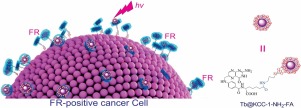当前位置:
X-MOL 学术
›
J. Pharmaceut. Biomed. Anal.
›
论文详情
Our official English website, www.x-mol.net, welcomes your feedback! (Note: you will need to create a separate account there.)
Spectrofluorimetric cytosensing of colorectal cancer cells using terbium-doped dendritic fibrous nano-silica functionalized by folic acid: A novel optical cytosensor for cancer detection.
Journal of Pharmaceutical and Biomedical Analysis ( IF 3.4 ) Pub Date : 2019-12-23 , DOI: 10.1016/j.jpba.2019.113077 Jafar Soleymani 1 , Mohammad Hasanzadeh 2 , Nasrin Shadjou 3 , Mohammad Hossein Somi 1 , Abolghasem Jouyban 2
Journal of Pharmaceutical and Biomedical Analysis ( IF 3.4 ) Pub Date : 2019-12-23 , DOI: 10.1016/j.jpba.2019.113077 Jafar Soleymani 1 , Mohammad Hasanzadeh 2 , Nasrin Shadjou 3 , Mohammad Hossein Somi 1 , Abolghasem Jouyban 2
Affiliation

|
A novel fluorescent probe for detection of HT 29 cancer cells was developed based on terbium-doped dendritic fibrous nanosilica functionalized by folic acid (Tb@KCC-1-NH2-FA). Using this probe, fluorescence signals was emitted by Tb@KCC-1-NH2-FA at 490 nm by applying 380 nm as excitation wavelength. The reported probe is based on the interaction between FA decorated on the surface of Tb@KCC-1-NH2-FA and folate receptor (FR) which is overexpressed on the surface of the most of cancer cells. Fluorescence microscopy and flow cytometry were utilized to verify the uptake of Tb@KCC-1-NH2-FA with FR-positive HT 29 cancer cells. The specificity of Tb@KCC-1-NH2-FA towards FR-positive cells was approved by staining HEK 293 cells as FR-negative cells with Tb@KCC-1-NH2-FA which obtained results approved selective differentiation of normal cells with the FA-decorated nanomaterials. The cytotoxicity of Tb@KCC-1-NH2-FA was evaluated by MTT assay which confirmed their biocompatible nature. Under optimum conditions, this cytosensor is able to detect HT 29 colon cancer from 500 to 6.5 × 103 cells/mL with lower limit of detection (LLOQ) of 500 cells/mL. Due to the room temperature stability of Tb@KCC-1-NH2-FA, this cytosensor could be developed in a simple way with exceptional specificity which may show potential applications for early stage detection of colon cancer.
中文翻译:

叶酸功能化的掺-树突状纤维纳米二氧化硅对大肠癌细胞的荧光光谱细胞传感:一种新型的光学细胞传感器,用于癌症检测。
基于叶酸(Tb @ KCC-1-NH2-FA)功能化的掺-树突状纤维纳米二氧化硅,开发了一种新型荧光探针,用于检测HT 29癌细胞。使用该探针,通过以380 nm作为激发波长,Tb @ KCC-1-NH2-FA在490 nm处发射了荧光信号。报告的探针基于装饰在Tb @ KCC-1-NH2-FA表面的FA与大多数癌细胞表面过度表达的叶酸受体(FR)之间的相互作用。荧光显微镜和流式细胞仪用于验证FR阳性HT 29癌细胞对Tb @ KCC-1-NH2-FA的摄取。Tb @ KCC-1-NH2-FA对FR阳性细胞的特异性是通过用Tb @ KCC-1-NH2-FA将HEK 293细胞染色为FR阴性细胞而获得的,该结果获得了批准的正常细胞选择性分化的结果。 FA装饰的纳米材料。通过MTT法评估了Tb @ KCC-1-NH2-FA的细胞毒性,证实了其生物相容性。在最佳条件下,该细胞传感器能够检测500到6.5×103细胞/ mL的HT 29结肠癌,最低检测限(LLOQ)为500细胞/ mL。由于Tb @ KCC-1-NH2-FA在室温下的稳定性,该细胞传感器可以以简单的方式开发并具有出色的特异性,这可能显示出在结肠癌早期检测中的潜在应用。通过MTT法评估了Tb @ KCC-1-NH2-FA的细胞毒性,证实了其生物相容性。在最佳条件下,该细胞传感器能够检测500到6.5×103细胞/ mL的HT 29结肠癌,最低检测限(LLOQ)为500细胞/ mL。由于Tb @ KCC-1-NH2-FA在室温下的稳定性,该细胞传感器可以以简单的方式开发并具有卓越的特异性,这可能显示出在结肠癌早期检测中的潜在应用。通过MTT法评估了Tb @ KCC-1-NH2-FA的细胞毒性,证实了其生物相容性。在最佳条件下,该细胞传感器能够检测500到6.5×103细胞/ mL的HT 29结肠癌,最低检测限(LLOQ)为500细胞/ mL。由于Tb @ KCC-1-NH2-FA在室温下的稳定性,该细胞传感器可以以简单的方式开发并具有出色的特异性,这可能显示出在结肠癌早期检测中的潜在应用。
更新日期:2019-12-23
中文翻译:

叶酸功能化的掺-树突状纤维纳米二氧化硅对大肠癌细胞的荧光光谱细胞传感:一种新型的光学细胞传感器,用于癌症检测。
基于叶酸(Tb @ KCC-1-NH2-FA)功能化的掺-树突状纤维纳米二氧化硅,开发了一种新型荧光探针,用于检测HT 29癌细胞。使用该探针,通过以380 nm作为激发波长,Tb @ KCC-1-NH2-FA在490 nm处发射了荧光信号。报告的探针基于装饰在Tb @ KCC-1-NH2-FA表面的FA与大多数癌细胞表面过度表达的叶酸受体(FR)之间的相互作用。荧光显微镜和流式细胞仪用于验证FR阳性HT 29癌细胞对Tb @ KCC-1-NH2-FA的摄取。Tb @ KCC-1-NH2-FA对FR阳性细胞的特异性是通过用Tb @ KCC-1-NH2-FA将HEK 293细胞染色为FR阴性细胞而获得的,该结果获得了批准的正常细胞选择性分化的结果。 FA装饰的纳米材料。通过MTT法评估了Tb @ KCC-1-NH2-FA的细胞毒性,证实了其生物相容性。在最佳条件下,该细胞传感器能够检测500到6.5×103细胞/ mL的HT 29结肠癌,最低检测限(LLOQ)为500细胞/ mL。由于Tb @ KCC-1-NH2-FA在室温下的稳定性,该细胞传感器可以以简单的方式开发并具有出色的特异性,这可能显示出在结肠癌早期检测中的潜在应用。通过MTT法评估了Tb @ KCC-1-NH2-FA的细胞毒性,证实了其生物相容性。在最佳条件下,该细胞传感器能够检测500到6.5×103细胞/ mL的HT 29结肠癌,最低检测限(LLOQ)为500细胞/ mL。由于Tb @ KCC-1-NH2-FA在室温下的稳定性,该细胞传感器可以以简单的方式开发并具有卓越的特异性,这可能显示出在结肠癌早期检测中的潜在应用。通过MTT法评估了Tb @ KCC-1-NH2-FA的细胞毒性,证实了其生物相容性。在最佳条件下,该细胞传感器能够检测500到6.5×103细胞/ mL的HT 29结肠癌,最低检测限(LLOQ)为500细胞/ mL。由于Tb @ KCC-1-NH2-FA在室温下的稳定性,该细胞传感器可以以简单的方式开发并具有出色的特异性,这可能显示出在结肠癌早期检测中的潜在应用。


























 京公网安备 11010802027423号
京公网安备 11010802027423号